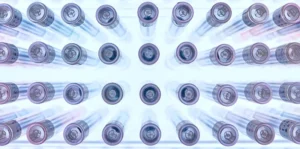DECEMBER 12, 2012
What Does DNA Look Like? The First Ever Direct Photograph of DNA
A team of Italian scientists have taken a snapshot of a single DNA molecule for the first time using the electron microscope. This technological breakthrough comes after years of depending on X-ray diffraction to provide indirect, albeit useful, information on the structure of DNA.
In 1952, the groundbreaking X-ray diffraction image of DNA, dubbed Photo 51, led to the discovery of the helical structure of DNA. This image was produced by subjecting millions of DNA molecules in crystallized form to X-rays, which were then recorded on photographic film as they bounced off the DNA. Complex mathematics were required to interpret the resulting patterns.
The new technique involves affixing the DNA molecule to a bed of silicone nails, stretched out and ready to be photographed. Electron beams go through holes in the silicone bed and illuminate the DNA molecule, much as light would, for the photograph–the difference is that electron beams can go to a much higher resolution than light. The resulting photograph, a direct image, requires no mathematical calculations.
This new technique is expected to allow scientists to observe interactions of DNA with proteins and other important biological molecules.
Earlier this year, a team of scientists in London also produced an image of the DNA double-helix using atomic force microscopy, a technique which uses a surface-scanning method to produce a three-dimensional image. The scientists likened this technique to how a blind person would use a cane to deduce an object’s shape.
For more on DNA biology, visit our DNA education section.
*Images included with permission from “Direct Imaging of DNA Fibers: The Visage of Double Helix,” Gentile F. et al, Nano Letters Article ASAP. Copyright 2012 American Chemical Society.
About DNA Diagnostics Center (DDC)
DNA Diagnostic Center is the world leader in paternity and relationship testing. We serve healthcare professionals, government agencies, and individuals around the world to determine family relationships with trusted accuracy.
More Questions? Don’t hesitate to call us: we’re here to help!
CALL NOW





